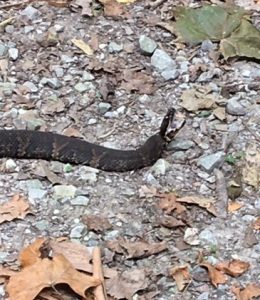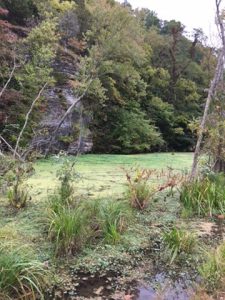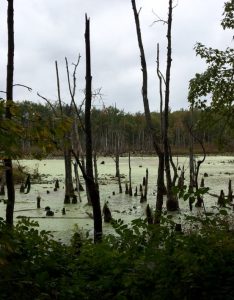Take a Pleasant Drive South for Sights Along Snake Road
by Susan Rick
Snakes are an often misjudged and unappreciated reptilian species. As a small child growing up under the shadows of our rocky bluffs and then living along the Mississippi River, I encountered many snake species. My parents, like most others, were concerned for their children’s and pets’ safety when out-of-doors where they may encounter snakes. I grew up with a general dislike of or fear of snakes. Any dead snake was a good snake.
In reality, snakes are very misunderstood. They serve several beneficial functions and are a very diverse and often beautiful group of reptiles. They eat many different rodents and insects. Snakes are food in some cultures. I have eaten smoked snake jerky in Cambodia and rattlesnake at BBQs in Texas. Historically they have appeared in many cultures’ religious writings often thought of as healers or divine protectors and other times, more recently, represented as evil and Satan. Snakes are kept as docile, very low maintenance pets requiring little space and fed infrequently.
Worldwide there are about 3,600 different species, most nonvenomous. In Illinois we have 40 species of snakes with only 4 venomous. Eleven of the species occurring in Illinois are listed as either endangered or threatened species. Populations have been decreasing due to being misunderstood and killed, collected, whether for pets (highly regulated in Illinois) or display, and due to destruction of habitat.

The four venomous species are Timber rattlesnakes, Eastern Massasauga, Eastern copperheads and Northern cottonmouths. Copperheads are in the southern 2/3 of Illinois. Massasauga only appear in a few counties north of here and are state endangered. Rattlesnakes are in the rocky areas of Illinois and are state threatened. Cottonmouths do not appear north of Carbondale. None of these snakes are aggressive to people and would only strike if stepped on, injured or threatened. Snakes, venomous or not, do not prey on humans. Prairie Research Institutes’ Illinois Natural History Survey has an ID key if you are seeking help to identify a snake you may come across (https://www.inhs.illinois.edu/outreach/keys/s01/).
Snakes are ectothermic or cold blooded. Their body temperature is the same as their surroundings. As fall and cold weather is approaching they are seeking places to hibernate. They usually hibernate in burrows, under rock piles, in fallen trees, etc. In our area it is common for snakes to migrate to our bluff lands to overwinter.
Southern Illinois has a unique place to observe this snake migration. La Rue-Pine Hills/Otter Pond Research Natural Area closes LaRue Road, more affectionately called Snake Road, twice a year to protect reptiles and amphibians as they cross the road to and from their wintering homes. The area is home to 1,200 species of plants and animals, many that are threatened or endangered. 66% of amphibians in Illinois and 59% of the reptiles have been recorded here. The area is also an important resting area for migrating waterfowl.

Ground temperature appears to be an important trigger to begin migration to and from the bluffs. Since 1972, IDNR has closed the road to protect the snakes and amphibians with the changing of the seasons. It is closed to all but foot traffic March 15 to May 15 and September 1 to October 30 each year. The road runs 2.5 miles along the base of the bluffs and can be accessed from the north or the south. There is a small parking lot at Winter Pond on the north end off Muddy Levee Road going right at the T. The trail is an easy walking gravel road.
I first became acquainted with Snake Road while a student at Southern Illinois University, Carbondale. A fellow graduate student had a permit to study the algae in Winter Pond. I was the only one who would help collect algae during migration time. Obviously, my fear of snakes had diminished over time! Snakes of all varieties seemed to be everywhere. We watched every step we took and every reed or bush in the water for snakes draped in them. I don’t know if my memory over time has exaggerated the amount of snakes that were there, but there seemed to be many, many more then than we saw recently. We saw six, five of which were cottonmouths.

Regardless, La Rue-Pine Hills is a fabulous place to visit, just ask my friend I took along who thought she was going on a picnic! Looking for snakes and other amphibians is fun. The swamps are interesting and beautiful with their variety of plants in the water and sprouting out of the trunks or on logs. No visit is complete either without going to the top of Pine Hills and looking over the Mississippi and Big Muddy river valleys. Spring wildflowers on the south end of the trail are also fun to view and, needless to say, as are the changing of the leaves in the fall. Remember: gathering, herding, harassing or having any snake in your possession is prohibited.
CLIFFTOP, a local nonprofit organization, is focused on preserving and protecting area bluff lands.
A version of this article appeared in the October 16, 2020 edition of the Monroe County Independent.
©2020 all content rights reserved Clifftop NFP
Comments are currently closed.
